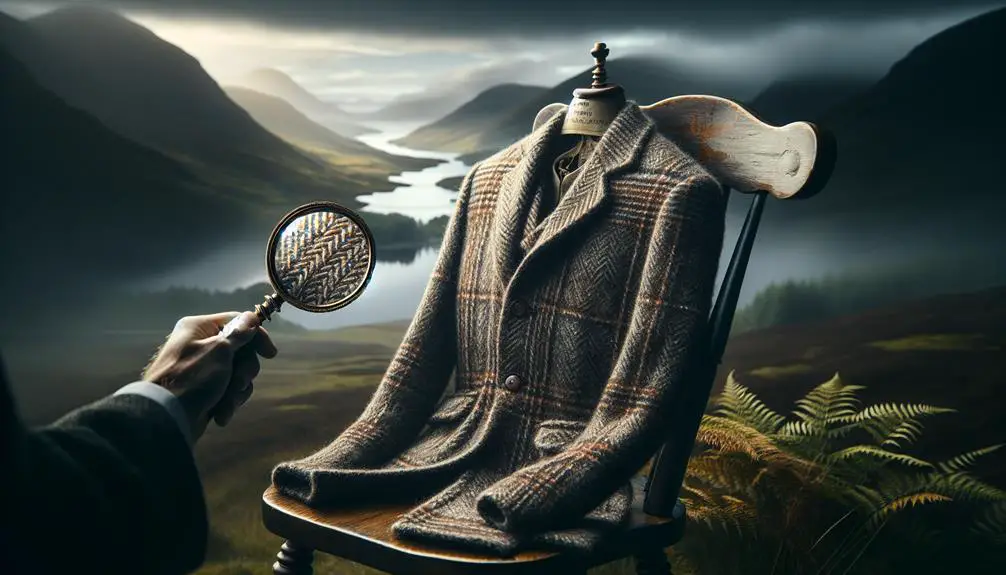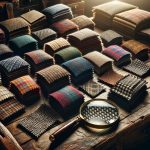I've always been intrigued by the durability of tweed. It's not just any fabric; its dense weave and woolen fibers give it a toughness that's hard to match. Whether it's resisting wear and tear or keeping its shape after years of use, tweed seems to handle it all with ease. But what really sets it apart in the world of fabrics, and how does it stack up against newer materials? Let's explore why this traditional textile has remained a staple in wardrobes around the globe and consider whether it still holds up in today's fast-paced, fashion-forward world.
Table of Contents
Key Takeaways
- Tweed's durability is enhanced by its tight weave and natural fiber composition.
- The inclusion of synthetic fibers in modern tweed increases its strength and weather resistance.
- Traditional weaving techniques, like the herringbone pattern, contribute to tweed's longevity and resilience.
- Tweed resists everyday wear and tear better than many other fabrics, maintaining its form and texture.
- Proper care, including gentle cleaning and proper storage, significantly extends the lifespan of tweed garments.
History of Tweed Fabric
Tweed's roots trace back to Scotland's Outer Hebrides, where it was first woven by islanders to battle the harsh, cold climate. This fabric wasn't just a functional choice; it became deeply entwined with the cultural fabric of the region. Originally, tweed was a practical solution for local farmers and fishermen who needed durable and water-resistant clothing to withstand their daily grind. However, its cultural significance grew as it began to symbolize the rugged Scottish landscape and the resilience of its people.
The term 'tweed' itself is believed to have come from a simple misreading or mishearing of the Scots word 'tweel,' which means twill, the traditional weave of the fabric. This linguistic twist is said to have occurred when a London merchant misinterpreted the handwriting on a label, marking the beginning of tweed's journey from a local craft to a globally recognized fabric.
As tweed's popularity soared, it started to be adopted by the aristocracy and later by fashion houses, which crafted everything from suits to accessories out of tweed, further cementing its status in cultural heritage. This evolution from humble beginnings to a luxury icon highlights not just its utility, but its enduring appeal across generations and social classes.
Composition of Tweed
Now, let's look at what tweed is made from and how it's woven together.
Tweed fabric materials and weaving techniques play a huge role in its durability.
I'll explain these aspects to give you a better understanding of why tweed holds up so well.
Tweed Fabric Materials
Tweed is primarily woven from wool, but it can also include blends of cotton, silk, or synthetic fibers for various textures and durability. Originating in Scotland, tweed's popularity has soared due to its robustness and adaptability.
This fabric isn't just for traditionalists; it's evolved into a staple for fashion-forward, outdoor enthusiasts, and anyone in between. The unique properties of wool—natural elasticity and breathability—combine with other materials to enhance tweed's appeal.
Cotton adds softness, silk increases sheen, and synthetics can boost strength and resistance to wear. Understanding these blends is essential for recognizing why tweed remains a preferred choice in both high fashion and practical wear, standing the test of time in durability and style.
Weaving Techniques Explained
Understanding the materials used in tweed sets the stage for exploring how it's woven into the durable fabric we value. The weaving process hinges greatly on the selection of loom types and the mastery of thread tension. Different looms impact the texture and strength of tweed. Traditional looms, for instance, allow for a tighter weave, which is important for enhancing the fabric's resilience and weather-resistant qualities.
Managing thread tension is equally essential. It must be precise; too tight, and the threads might snap, too loose, and the fabric loses its shape. I've found that maintaining a balanced tension throughout the weaving process ensures that the tweed not only looks impeccable but also stands up to wear and tear exceptionally well.
Weaving Techniques Explained
Now, let's look at how tweed is made.
We'll start with the traditional herringbone weave, which is a staple in tweed production.
Then, I'll touch on some of the modern innovations that are mixing things up in the tweed world.
Traditional Herringbone Weave
Let's explore how the traditional herringbone weave is crafted, a technique renowned for its durability and intricate pattern. This style involves alternating columns of slanting lines, which creates a distinctive V-shape reminiscent of a fish skeleton—that's where the pattern gets its name. What's fascinating is how this method uses color variations to enhance the texture visually, making the fabric not just durable but also aesthetically appealing.
The significance of the pattern goes beyond aesthetics; it historically signifies quality and sophistication in garments. By mastering this weave, you appreciate not just the craft but also the tradition it carries. Each interlocking thread isn't just weaving fabric; it's weaving history. Understanding this helps us appreciate why tweed has stood the test of time.
Modern Tweed Innovations
While traditional tweed relies on time-honored weaving patterns, today's innovations frequently incorporate advanced techniques to enhance both function and fashion. I've seen technological adaptations that really push the envelope. For instance, they're integrating synthetic fibers with classic wool to boost durability and add weather resistance. This isn't just about making tweed tougher; it's about tailoring it to modern needs without sacrificing its unique, rustic charm.
Performance enhancements are another significant win. Modern tweed can now include stretch fibers that improve wearability and comfort, essential for active use. These tweaks make the fabric more adaptable, ensuring it performs well in various environments, from windy moors to chic urban settings. It's fascinating to see how these innovations keep such a traditional fabric relevant today.
Types of Tweed Available
Tweed comes in various types, each with unique textures and patterns. When I'm picking out a fabric, I'm not just looking at durability; I'm also eyeing the tweed colors and patterns that best express my style. You'll find that tweed can range from subtle earth tones to vibrant plaids. Each pattern, whether herringbone, check, or houndstooth, adds a distinct character to the fabric.
Harris Tweed is perhaps the most renowned, known for its rich, dyed fibers spun from pure virgin wool. It's handwoven by islanders in Scotland's Outer Hebrides, and it's got a bit of a rough texture that's perfect for classic outerwear. Then there's Donegal tweed, famous for its colorful speckles and originating from Ireland. This type is typically lighter and has a softer finish, ideal for those who prefer a more refined look.
Each type of tweed has its fan base, depending on the use—whether it's for a durable, stylish jacket or a pair of statement trousers. Understanding these options helps me make informed decisions about which tweed will suit my needs, ensuring I'm not just fashionable but also practical in my choices.
Tweed's Resistance to Elements
Now, let's talk about how tweed stands up against the elements.
It's pretty impressive how this fabric manages to be both weatherproof and naturally resistant to wear and tear.
I'll take a closer look at these qualities and what makes tweed such a durable choice for clothing.
Weatherproof Qualities Explored
One of the standout features of tweed is its remarkable ability to guarantee water and wind resistance. This resilience makes it a top choice for anyone who's outdoors frequently, regardless of the weather. The fabric's tight weave not only blocks chilly breezes but also helps maintain warmth, enhancing tweed insulation qualities. This means I'm not just dry but also comfortably warm, even on damp, windy days.
Moreover, tweed's natural fibers possess excellent color retention. This guarantees that the fabric doesn't just stand up well to rain and gusts but also holds its color beautifully over time. So, my tweed jacket isn't just practical; it stays vibrant and rich in hue, looking as great as it performs.
Natural Wear Resistance
Beyond its ability to handle weather, I've found that tweed also resists everyday wear and tear remarkably well. This durability is partly due to its unique texture analysis. The fabric's tight weave and rough surface mean it can withstand frequent use without showing much distress.
I've noticed that color variations in the tweed also play an essential role. These subtle shifts in shade not only enhance the fabric's aesthetic appeal but also help to disguise minor stains and scuffs, extending the garment's life.
Moreover, the natural fibers used in tweed contribute to its resilience. They're inherently tough and provide a robust barrier against physical damage. This combination of features makes tweed a top choice for anyone looking for long-lasting, stylish wear.
Comparing Tweed to Other Fabrics
When delving deeper into how it stacks up against some popular alternatives, tweed stands out for its exceptional durability and classic appeal. Let's explore how it measures up against some popular alternatives:
- Denim: Though denim is tough, tweed beats it in the sophistication stakes. However, denim offers better fabric flexibility, which is a win for casual comfort.
- Wool: Similar in durability, wool fabrics generally have great color retention like tweed. Yet, tweed's thick, tight weave gives it a sturdier feel, perfect for harsh weather.
- Cotton: Cotton is lighter and cooler, making it ideal for warmer climates. But when it comes to withstanding the test of time, tweed holds its form and texture far better.
- Silk: Silk exudes luxury and has a soft, delicate charm. In terms of durability, though, it doesn't come close to tweed. Tweed's robustness is unmatched, especially in maintaining its rich colors and intricate patterns.
I've always appreciated how tweed maintains its elegant look while being incredibly hard-wearing. It doesn't just keep up; it often surpasses other materials in retaining its color and structural integrity over time. For anyone valuing longevity and style, tweed is a standout choice.
Maintenance and Care Tips
To explore further, always address stains immediately—they're easier to manage before they set. Use a gentle stain remover designed for wool; harsh chemicals can do more harm than good. For everyday dust and lint, a soft-bristled brush works wonders. It's a simple step that keeps your tweed smooth and clean without stressing the fabric.
Avoiding color fading is another key aspect. Tweed should never be left in direct sunlight for extended periods. When storing, choose a cool, dark place. Also, consider using padded hangers to maintain the shape of jackets or coats without stretching the shoulders.
Here's a quick table summarizing these care tips:
| Care Aspect | Tool/Method | Tip |
|---|---|---|
| Stain Removal | Gentle stain remover | Act quickly and use wool-safe products. |
| Daily Maintenance | Soft-bristled brush | Regular brushing removes surface dirt. |
| Prevent Color Fade | Proper storage | Avoid sunlight, use cool dark places. |
Longevity of Tweed Garments
With proper care, tweed garments can last for decades, becoming timeless pieces in your wardrobe. I've noticed that despite shifts in fashion trends, tweed's unique texture and color variations keep it perpetually relevant. Its durability isn't just about the fabric's resistance to wear and tear; it's also about how it gracefully adapts over time.
Here's how you can guarantee your tweed stays in top condition:
- Regular Cleaning: Avoid frequent heavy washes, but do brush and air out tweed regularly to preserve its fibers.
- Proper Storage: Hang tweed garments on padded hangers and store them in a cool, dry place to prevent misshaping and moisture damage.
- Mending Minor Damages: Repair small tears and loose threads immediately to maintain the garment's structure.
- Mindful Usage: Rotate your wardrobe to avoid overusing your favorite tweed pieces, which helps reduce stress on the fabric.
Tweed in Modern Fashion
Tweed has seamlessly evolved into modern fashion, preserving its classic appeal while adjusting to contemporary trends. As I've observed, it's not just about the old-school charm anymore; tweed integrates with cutting-edge designs, making it a staple on global runways. You'll spot tweed making bold appearances in both autumn and winter collections, reinterpreted with modern cuts and mixed textures that appeal to a diverse audience.
Watching recent tweed runway trends, it's clear designers are pushing boundaries. They're incorporating metallic threads, experimenting with asymmetrical cuts, and pairing it with unconventional materials like silk and leather. This transformation guarantees tweed remains relevant and exciting.
Celebrity tweed styles also play a huge role in its modern resurgence. Icons like Emma Watson and Ryan Gosling have been spotted rocking tweed in ways that stray far from stuffy. Watson's choice of a sleek tweed mini-dress or Gosling's sharp tweed blazer at public events showcases just how versatile and fashionable tweed can be.
It's evident that tweed isn't just surviving; it's thriving, adapting to the pulse of current fashion needs. It honors its heritage while embracing innovation, proving that some materials never truly go out of style—they just reinvent themselves.
Future of Tweed Sustainability
As we explore how tweed adapts to modern trends, it's equally important to contemplate its sustainability in the fashion industry. Tweed, with its roots deeply embedded in tradition, faces the challenge of evolving while maintaining ethical and environmental integrity. Here's how this timeless material can continue to thrive sustainably:
- Enhanced Recycling Processes: Improving the recycling techniques for tweed can minimize waste and make use of post-consumer fabric more efficiently.
- Ethical Sourcing of Raw Materials: Committing to the use of ethically sourced wool guarantees the welfare of animals and supports local farmers who adhere to sustainable practices.
- Local Production to Reduce Carbon Footprint: By keeping production local, we can significantly reduce the emissions associated with transporting materials across the globe.
- Biodegradable Dyes and Treatments: Switching to natural dyes and chemical treatments that are less harmful to the environment helps in reducing the overall ecological impact of tweed production.
Embracing these practices not only aligns with global sustainability goals but also appeals to a consumer base that's increasingly conscious about the origins and lifecycle of their clothing. Let's continue to champion tweed while safeguarding the planet.
Frequently Asked Questions
Can Tweed Be Dyed at Home Effectively?
I've found that dyeing tweed at home can be effective with the right techniques. Ensuring color retention might require specific dyes and careful application to maintain the fabric's unique texture and appearance.
Is Tweed Suitable for Summer Wear?
I wouldn't recommend tweed for summer wear; it's heavy and retains heat, lacking the breathability needed for warmer weather. Lightweight fabrics are better for staying cool and comfortable during the summer months.
Are Tweed Fabrics Hypoallergenic?
I've found that tweed's composition isn't inherently hypoallergenic as it can include allergy triggers like wool. It's best to check if you're sensitive to specific materials before picking a tweed garment.
How Does Tweed Impact Skin Sensitivity?
Tweed's fabric texture can be rough, which might irritate sensitive skin, leading to allergic reactions for some. I've found it's important to choose softer tweeds if you're prone to skin sensitivity issues.
Can Tweed Be Recycled or Upcycled?
I've explored tweed repurposing and found it fits well with sustainability practices. You can definitely recycle or upcycle tweed, transforming it into new garments or even home decor items. It's quite versatile!
- Is Tweed More Expensive Than Wool? - April 24, 2024
- Is Tweed Fabric Itchy? - April 24, 2024
- How Durable Is Tweed? - April 24, 2024








